Questions about police violence fuel outrage over death of young Black male
By Askia Muhammad, Nisa Islam Muhammad, Charles Robinson and Shawn Massie | Last updated: Apr 28, 2015 - 8:07:18 AMWhat's your opinion on this article?
Questions about police violence fuel outrage over death of young Black male, the crisis is far from over and not limited to the city of Baltimore, say activists and demonstrators in the streets
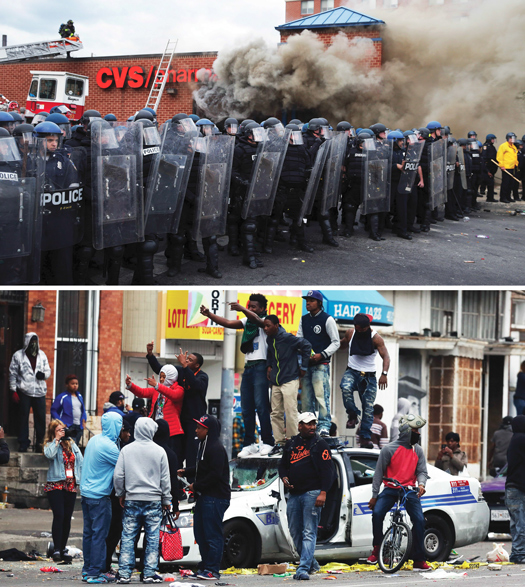
(Top) Baltimore Police form a perimeter around a CVS pharmacy that was looted and burned near the corner of Pennsylvania and North avenues during protests April 27 in Baltimore, Maryland. (lower) Demonstrators climb on a destroyed Baltimore Police car in the street near the corner of Pennsylvania and North avenues during protests following the funeral of Freddie Gray April 27 in Baltimore, Maryland. Photos: Chip Somodevilla/Getty Images
|
BALTIMORE (FinalCall.com) - From Staten Island, to Ferguson, to Cleveland, to North Charleston, S.C., now to the city by the Bay, death after death of unarmed Black men by police has stunned the country—but one death is so gruesome and seemingly unjustified, it has left the nation breathless.
Cries for justice for West Baltimore’s Freddie Gray grew louder each day for a week with larger and larger demonstrations and protests that overlapped with a 250-mile, nine-day “March 2 Justice” from Staten Island, N.Y. to the U.S. Capitol grounds. Organized by the Justice League NYC, the marchers arrived in the nation’s capital, April 21, after doubling back to nearby Baltimore, and ending with a march back to Washington on the west lawn of the Capitol for a rally.
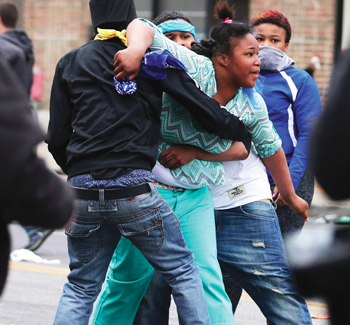
A woman screams, ‘Kill me’ at the Baltimore Police during violent protests at the corner of Pennsylvania and North avenues in Baltimore, Maryland.
|
The detour for the March 2 Justice came as news and eyewitness accounts of Mr. Gray’s arrest and takedown poured out after his death April 19, one week after his arrest. Mr. Gray’s voice box was crushed and his spine was “80 percent severed at his neck.” Video shot by a bystander shows him screaming in apparent agony as police drag him to a van.
“His leg looks broke! Look at his f—ing leg! Look at his f—ing leg! That boy’s leg looks broke! His leg’s broken! Y’all dragging him like that!” one bystander said in the video.
Just one day after Mr. Gray’s death, six police officers were immediately suspended with pay. Police said an autopsy confirmed Mr. Gray died of spinal cord injuries. He may have been injured while inside a police van, but that cause is disputed by witnesses.
Mr. Gray was allegedly arrested after he ran away when a police lieutenant “made eye contact” with him. He was charged with carrying a knife. Authorities admitted neither possessing a knife nor running away are prima facie criminal acts. Officials confirmed Mr. Gray asked for an asthma inhaler, but a medic wasn’t called to assist him until 40 minutes later.
Just two days after his passing the Justice Department announced it had launched a federal investigation into the death.
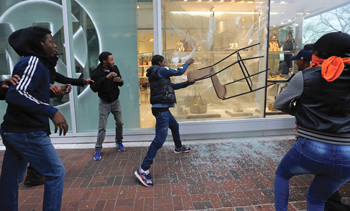
A protestor breaks a window at a store after a rally for Freddie Gray, April 25, in Baltimore. Gray died from spinal injuries about a week after he was arrested and transported in a police van.
|
An eyewitness said police “bent (Mr. Gray) like a pretzel,” with a knee in the back of his neck. Police confirmed Mr. Gray was not wearing a seat belt in the police transport van where he was handcuffed and his legs shackled. That was a violation of policy and Mr. Gray should have received medical attention at the arrest scene and when he asked for it in custody, said top police officials.
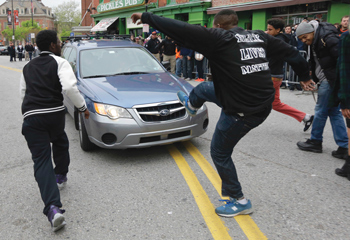
Protestors chase after a car as it drives in reverse after a rally for Freddie Gray, April 25, in Baltimore.
|
He was released from maximum security in the Maryland State Penitentiary in March 2014 after 44-years confinement for a crime he insists he did not commit, the murder of a Baltimore police officer. The Supreme Court overturned Mr. Conway’s conviction which led to his release.
“The paddy wagon was right there,” Ms. Jackson continued in the interview with Mr. Conway. “They took the young man out, beat him some more. The man wasn’t responding. They took him by his pants, and he was dragged. And I asked them to call an ambulance. They told me to mind my business. I told them it is my business. And they just threw him up in there. The boy wasn’t hollering or nothing. How can you holler if you ain’t saying nothing? They killed that young man. They killed him,” she said.
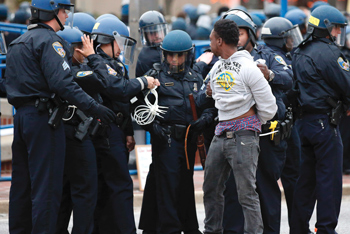
Police detain a man after a march to City Hall for Freddie Gray, April 25 in Baltimore.
|
Mr. Conway told “Democracy Now!” “The incident actually occurred under one of the police cameras that have been operating for years in that community, and they have been using that camera to make numerous drug arrests over the years. And for some reason, that day, that camera did not work. It would have been directly over Freddie Gray’s head. It would have recorded everything that took place.
“One of the things that people say, that one of the police dropped down on his back, on his neck with his knee, and from that point on, he was incapacitated,” he continued. “And later, they even took him back out of the van and shackled his legs and did something else to him and threw him back in the van.
“So, as far as all the witnesses can tell and all of them report, that he was already fatally injured when they put him in, in the first place. That video that we saw with them dragging him to the van, he was already incapacitated,” Mr. Conway said.
Activists seek police reform from Congress
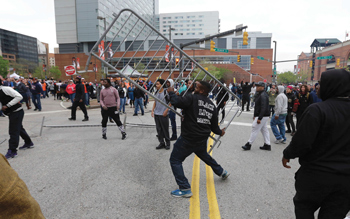
A protestor throws a barricade at a bar near Oriole Park at Camden Yards after a rally for Freddie Gray, April 25, in Baltimore.
|
“Our feet are tired, our legs hurt, our knees hurt, but it really doesn’t compare to the pain which the families of those that have lost their lives to police brutality have been experiencing,” said Carmen Perez, the march director April 21. “We march in their spirit.” The rally gathered close to 500 hundred people from the East Coast and as far away as Detroit.
Several members of the Congressional Black Caucus spoke including Reps. John Lewis (D-Ga.), Keith Ellison (D-Minn.), Andre Carson (D-In.), Sheila Jackson Lee (D-Texas.), Barbara Lee (D-Calif.) and Yvette Clark (D-N.Y.).
“I’m excited to be here,” actor and organizer Danny Glover told the rally. “You’re making history right now. This is your day and your time.”
Justice League NYC is a task force of juvenile and criminal justice experts, advocates, artists and formerly incarcerated individuals, brought together under the banner of “The Gathering for Justice,” a social justice organization founded by Harry Belafonte in 2005 and led by Executive Director Carmen Perez and co-chairs Linda Sarsour and Tamika Mallory from Harlem. Their goal is to build a movement that is intergenerational and community-oriented.
The group’s proposed “justice package” would hold authorities accountable and re-direct funds from un-needed police militarization projects into education and job development activities, said Jasiri X, who is part of the group.
A group of 50-60 protesters completed the entire march from Staten Island, stopping in key East Coast cities before reaching Washington.
Throughout the nine-day walk, smaller groups joined the walk, where they sometimes encountered hostile angry White bystanders, waving Confederate flags, shouting racial slurs, even telling them on occasions, to “Get a job.”
Marching for Freddie Gray
After six days of rallying, thousands gathered April 25 for a peaceful protest over the death of the 25-year-old. The diverse group of demonstrators marched for three miles, from Gilmore Homes, a housing project in West Baltimore where the Gray arrest took place, to City Hall downtown.
“I’m terrified to walk out here, not because of the men on the corner, it’s because of the officers,” said Shyteak Lawrence, a Gilmore Homes resident.
As the demonstrators left from the Western Police District, a regular protest site, marchers went throughout West Baltimore, causing traffic jams and roadblocks.
“I wish that I could say that it’s going to end, but I’m glad that it’s erupting here. Baltimore has been a quiet spot and I’m glad that people are getting up and speaking out. It’s been enough already,” said Laura Raskin of Mt. Washington. The White woman attended the protest with her husband and daughter. Her husband Ian wants to see officers involved with Mr. Gray’s death heavily investigated.
“I want to see the police establishing better relationships, especially with Black men,” said Umar “Marvin” McDowell. Mr. McDowell, the owner of a youth boxing program called “Umar Boxing” in West Baltimore had a personal encounter with the police that left him disgusted.
He recalled an incident last year when officers harassed a group of his pupils. “The first group of cops that pulled them over called for backup. When backup came, he told them to get out of the car and made them sit on the curb in the rain.”
McDowell believes sensitivity training is needed to prevent further police deaths.
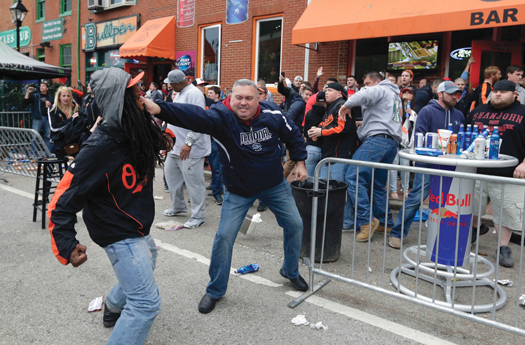
protestor, left, fights with a bar patron outside of a bar near Oriole Park at Camden Yards after a rally for Freddie Gray, April 25, in Baltimore. Photos: AP/Wide World photos
|
Downtown confrontation
It’s not what the city leaders said was wanted but those who came to foment confrontation found it April 25 outside a baseball game. For most of the day, thousands walked from the scene of the Gray death to City Hall. Organizers emphasized they wanted to shut down the city. They clogged main arteries as some chanted, “No justice, no peace.” “All night, all day we will fight for Freddie Gray,” chanted others.
Mostly civil protests changed as small groups took up positions along Pratt Street, a main city artery. Some focused attention on Camden Yards where the Baltimore Orioles were playing the Boston Red Sox.
Protesters converged at the ticket area, forcing the hand of Baltimore Police who donned riot gear. Officers were tasked with keeping protesters away from game. Double lines of officers endured peltings of trash cans, water bottles, and taunts.
Things escalated with protesters hurling trash cans at marked and unmarked police cars, breaking windows. It wasn’t long before arrests were made. The taunting would normally create an adversarial response, but there was some restraint.
There was looting of a 7-11, along with random smashing of store front windows of businesses near the tourist attraction Inner Harbor.
“I am disappointed,” said Mayor Stephanie Rawlings-Blake during a late night press briefing. At the briefing Freddie Gray’s twin sister, Frederica Gray, said, “can y’all please stop this; this is not what Freddie would want.”
Numbers told the story, 34 arrested, four juveniles, most were Baltimore residents.
Census data from the Sandtown-Winchester neighborhood tells the underlying story: An unemployment rate double that of the city (closing in on 20 percent), the highest concentration of formally incarcerated inmates, more than twice as many liquor and tobacco stores than other parts of the city, and no discernable industry to employ residents. Many juveniles in this neighborhood aren’t a part of a nuclear family. There is early interaction with police officers and that impacts future encounters.
Clinton James of West Baltimore brought his two sons to the protest. “They’re young,” he said. What happened to Mr. Gray, “shines a light on a natural problem. They are 16 and 14; they are right there and it could happen to them.”
Mr. West and his sons looked at the corner where Mr. Gray was first confronted by police.
Steven Fields came with his entire family to the Saturday march. The 52-year-old from East Baltimore said, “It seems apparent something is definitely wrong … being Black, young men and men it’s always been a struggle from day one. It’s easy to label it as a war; I wouldn’t label it a misunderstanding.”
(Charles Robinson and Shawn Massie reported from Baltimore and Askia Muhammad and Nisa Islam Muhammad reported from Washington, D.C.)
INSIDE STORIES AND REVIEWS
-
-
About Harriett ... and the Negro Hollywood Road Show
By Rabiah Muhammad, Guest Columnist » Full Story -
Skepticism greets Jay-Z, NFL talk of inspiring change
By Bryan 18X Crawford and Richard B. Muhammad The Final Call Newspaper @TheFinalCall » Full Story -
The painful problem of Black girls and suicide
By Charlene Muhammad -National Correspondent- » Full Story -
Exploitation of Innocence - Report: Perceptions, policies hurting Black girls
By Charlene Muhammad -National Correspondent- » Full Story -
Big Ballin: Big ideas fuel a father’s Big Baller Brand and brash business sense
By Bryan Crawford -Contributing Writer- » Full Story






 Click Here Stay Connected!
Click Here Stay Connected!








